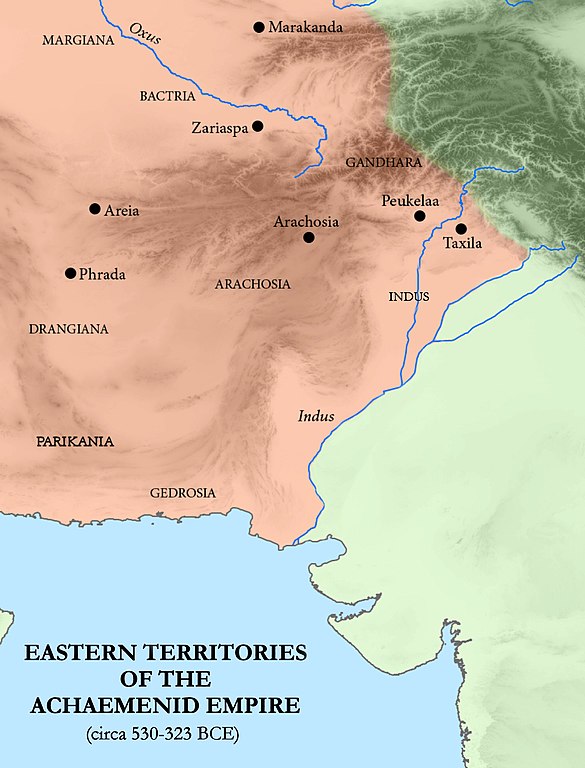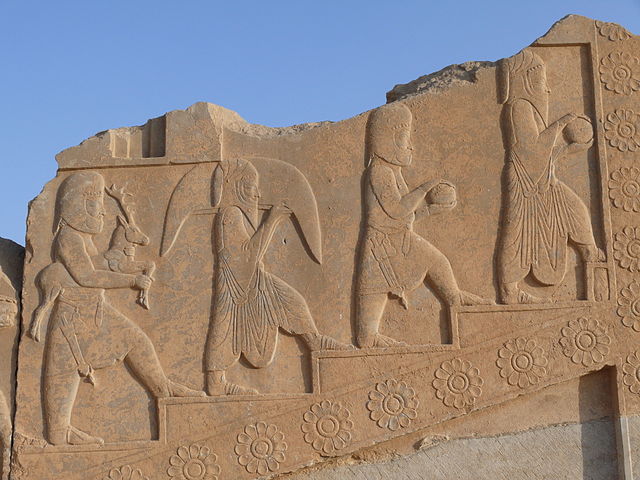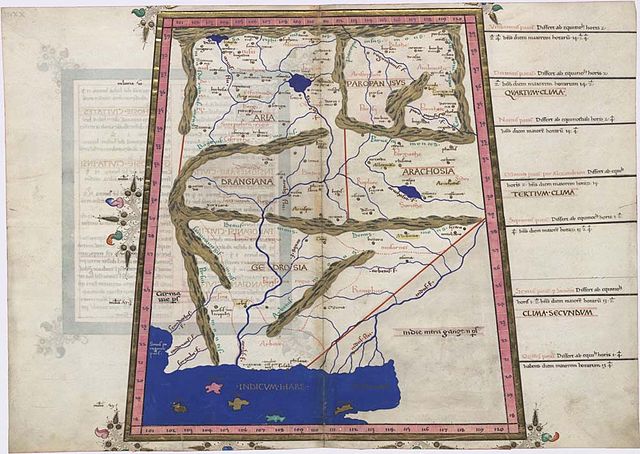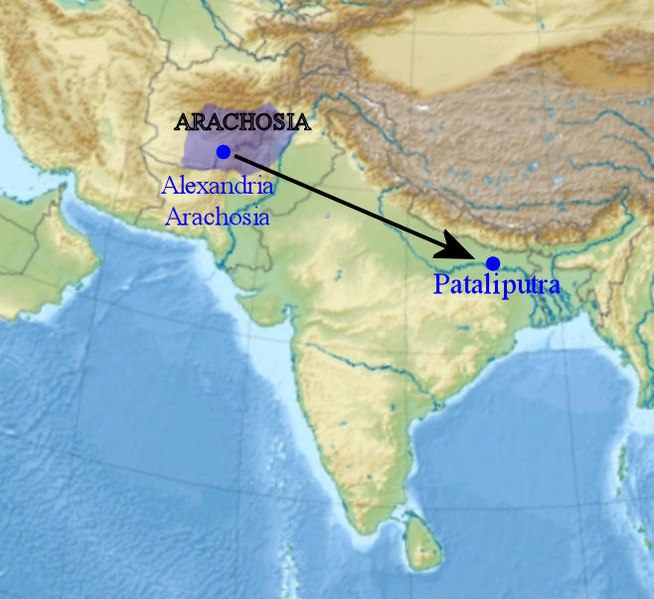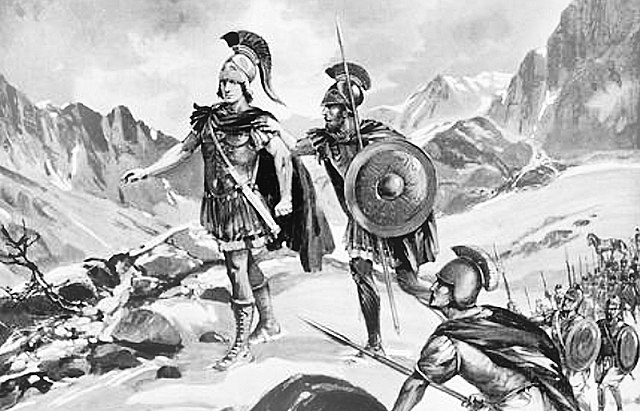
| ARACHOSIA
Eastern territories of the Achaemenid Empire, including Arachosia
Arachosian soldier of the Achaemenid army, circa 470 BCE, Xerxes I tomb
Arachosian priests of Zoroastrianism carrying various gifts and animals for a ritual of sacrifice at Persepolis Arachosia is the Hellenized name of an ancient satrapy in the eastern part of the Achaemenid, Seleucid, Parthian, Greco-Bactrian, and Indo-Scythian empires. Arachosia was centred on the Arghandab valley in modern-day southern Afghanistan, although its influence extended east to as far as the Indus River. The main river of Arachosia was called Arachotós, now known as the Arghandab River, a tributary of the Helmand River. The Greek term "Arachosia" corresponds to the Aryan land of Harauti which was around modern-day Helmand. The Arachosian capital or metropolis was called Alexandria Arachosia or Alexandropolis and lay in what is today Kandahar in Afghanistan. Arachosia was a part of the region of ancient Ariana.
Name :
The ancient Arachosia and the Pactyan people during 500 BC "Arachosia" is the Latinized form of Greek Arachosía. "The same region appears in the Avestan Videvdat (1.12) under the indigenous dialect form Haraxvaiti- (whose -axva- is typical non-Avestan)." In Old Persian inscriptions, the region is referred to as, written h(a)-r(a)-u-v(a)-t-i. This form is the "etymological equivalent" of Vedic Sanskrit Sarasvati-, the name of a river literally meaning "rich in waters/lakes" and derived from sáras- "lake, pond." (cf. Aredvi Sura Anahita).
"Arachosia" was named after the name of a river that runs through it, in Greek Arachotós, today known as the Arghandab, a left bank tributary of the Helmand.
Geography
:
In his list, Ptolemy also refers to a city named Arachotus or Arachoti (acc. to Strabo), which was the earlier capital of the land. Pliny the Elder and Stephen of Byzantium mention that its original name was Cophen. Hsuan Tsang refers to the name as Kaofu. This city is identified today with Arghandab which lies northwest of present-day Kandahar.
Peoples :
The inhabitants of Arachosia were Iranian peoples, referred to as Arachosians or Arachoti. They were called Pactyans by ethnicity, and that name may have been in reference to the present-day ethnic Pastun (Pashtun) tribes.
Isidorus of Charax in his 1st century CE "Parthian stations" itinerary described an "Alexandropolis, the metropolis of Arachosia", which he said was still Greek even at such a late time :
"Beyond is Arachosia. And the Parthians call this White India; there are the city of Biyt and the city of Pharsana and the city of Chorochoad and the city of Demetrias; then Alexandropolis, the metropolis of Arachosia; it is Greek, and by it flows the river Arachotus. As far as this place the land is under the rule of the Parthians."
—
"Parthians stations", 1st century CE. Original text in
paragraph 19 of Parthian stations
The region is first referred to in the Achaemenid-era Elamite Persepolis fortification tablets. It appears again in the Old Persian, Akkadian and Aramaic inscriptions of Darius I and Xerxes I among lists of subject peoples and countries. It is subsequently also identified as the source of the ivory used in Darius' palace at Susa. In the Behistun inscription (DB 3.54-76), the King recounts that a Persian was thrice defeated by the Achaemenid governor of Arachosia, Vivana, who so ensured that the province remained under Darius' control. It has been suggested that this "strategically unintelligible engagement" was ventured by the rebel because "there were close relations between Persia and Arachosia concerning the Zoroastrian faith."
Alexander the Great in Arachosia, 329 BCE The chronologically next reference to Arachosia comes from the Greeks and Romans, who record that under Darius III the Arachosians and Drangians were under the command of a governor who, together with the army of the Bactrian governor, contrived a plot of the Arachosians against Alexander (Curtius Rufus 8.13.3). Following Alexander's conquest of the Achaemenids, the Macedonian appointed his generals as governors (Arrian 3.28.1, 5.6.2; Curtius Rufus 7.3.5; Plutarch, Eumenes 19.3; Polyaenus 4.6.15; Diodorus 18.3.3; Orosius 3.23.1 3; Justin 13.4.22).
Following the Partition of Babylon, the region became part of the Seleucid Empire, which traded it to the Mauryan Empire in 305 BCE as part of an alliance. The Shung dynasty overthrew the Mauryans in 185 BC, but shortly afterwards lost Arachosia to the Greco-Bactrian Kingdom.
It then became part of the break-away Indo-Greek Kingdom in the mid 2nd century BCE. Indo-Scythians expelled the Indo-Greeks by the mid 1st century BCE, but lost the region to the Arsacids and Indo-Parthians. At what time (and in what form) Parthian rule over Arachosia was reestablished cannot be determined with any authenticity. From Isidore 19 it is certain that a part (perhaps only a little) of the region was under Arsacid rule in the 1st century CE, and that the Parthians called it Indike Leuke, "White India."
The Kushans captured Arachosia from the Indo-Parthians and ruled the region until around 230 CE, when they were defeated by the Sassanids, the second Persian Empire, after which the Kushans were replaced by Sassanid vassals known as the Kushanshas or Indo-Sassanids. In 420 CE the Kushanshas were driven out of present Afghanistan by the Chionites, who established the Kidarite Kingdom.
The Kidarites were replaced in the 460s CE by the Hephthalites, who were defeated in 565 CE by a coalition of Persian and Turkish armies. Arachosia became part of the surviving Kushano-Hephthalite Kingdoms of Kapis, then Kabul, before coming under attack from the Moslem Arabs.
These kingdoms were at first vassals of Sassanids. Around 870 CE the Kushano-Hephthalites (aka Turkshahi Dynasty) was replaced by the Hindu Shahi dynasty, which fell to the Muslim Turkish Ghaznavids in the early 11th century CE.
Arab geographers referred to the region (or parts of it) as 'Arokhaj', 'Rokhaj', 'Rohkaj' or simply 'Roh'.
Theory
of Croatian Iranian origin :
Source :
https://en.wikipedia.org/ |
